Planets Study guides, Class notes & Summaries
Looking for the best study guides, study notes and summaries about Planets? On this page you'll find 1957 study documents about Planets.
Page 4 out of 1.957 results
Sort by

-
AST101 Clicker Quizes UofT Questions and Answers 100% Pass
- Exam (elaborations) • 32 pages • 2024
-
- $9.99
- + learn more
AST101 Clicker Quizes UofT Questions and Answers 100% Pass What does the term "Solar System" mean? The Sun, the planets, and all of their moons What does the term "Universe" mean? The totality of all space, time, energy, and matter Earth is 1 AU from the Sun. What is the maximumpossible separation between Earth and Mars? (Hint: Mars is the next farthest planet from the Sun) 2.5 AU A 'light year' is a measure of: distance Stars are... balls of plasma which produce energy ...
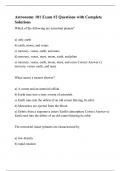
-
Astronomy 101 Exam #2 Questions with Complete Solutions
- Exam (elaborations) • 22 pages • 2024
-
- $13.99
- + learn more
Which of the following are terrestrial planets? a) only earth b) earth, moon, and venus c) mercury, venus, earth, and mars d) mercury, venus, mars, moon, earth, and pluto e) mercury, venus, earth, moon, mars, and ceres Correct Answer-c) mercury, venus, earth, and mars What causes a meteor shower? a) A comet and an asteroid collide. b) Earth runs into a stray swarm of asteroids. c) Earth runs into the debris of an old comet littering its orbit. d) Meteorites are ejected from the M...
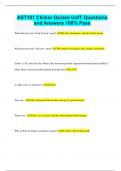
-
AST101 Clicker Quizes UofT Questions and Answers 100% Pass
- Exam (elaborations) • 32 pages • 2024
-
- $10.49
- + learn more
What does the term "Solar System" mean? The Sun, the planets, and all of their moons What does the term "Universe" mean? The totality of all space, time, energy, and matter Earth is 1 AU from the Sun. What is the maximumpossible separation between Earth and Mars? (Hint: Mars is the next farthest planet from the Sun) 2.5 AU A 'light year' is a measure of: distance Stars are... balls of plasma which produce energy by nuclear fusion. Planets are.. rocky, icy, or gassy, and they don't p...
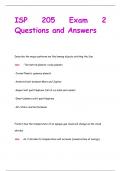
-
ISP 205 Exam 2 Questions and AnswersISP 205 Exam 2 Questions and Answers
- Exam (elaborations) • 26 pages • 2024
- Available in package deal
-
- $12.49
- + learn more
Describe the major patterns we find among objects orbiting the Sun. Ans- -Terrestrial planets: rocky planets -Jovian Planets: gaseous planets -Asteroid belt between Mars and Jupiter -Kuiper belt past Neptune full of ice balls and comets -Dwarf planets orbit past Neptune -All rotate counterclockwise Predict how the temperature of an opaque gas cloud will change as the cloud shrinks Ans- As it shrinks its temperature will increase (conservation of energy) Explain how the nebular theory ...

-
Astronomy 1010 Exam #2 Chapter 12 with Complete & Verified Solutions
- Exam (elaborations) • 12 pages • 2024
-
- $8.99
- + learn more
Astronomy 1010 Exam #2 Chapter 12 with Complete & Verified Solutions During the formation of the Solar System, smaller particles in the solar nebula combined to form planetesimals, some of which provided the building blocks for planets. The majority of planetesimals did not become planets, however, and some of them remain in the Solar System today as debris left over from the time of planet formation. Asteroids are a special class of planetesimals that orbit around the Sun.

-
Final Exam AST 111 || with Accurate Answers 100%.
- Exam (elaborations) • 24 pages • 2024
-
Available in package deal
-
- $13.39
- + learn more
Astronomical Unit correct answers Earth's average distance from the sun, equal to 1.5 x 10^8 km Solar system correct answers consists of the sun, its family of planets, some smaller bodies, such as, moons and comets planets correct answers small, spherical, non-luminous bodies that orbit a star and shine by reflected light star correct answers a self-luminous ball of hot gas that generates its own energy light year (ly) correct answers the distance that light travels in one year, ap...
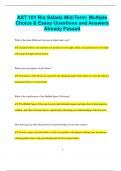
-
AST 101 Rio Salado Mid-Term: Multiple Choice & Essay Questions and Answers Already Passed
- Exam (elaborations) • 62 pages • 2024
-
- $11.99
- + learn more
AST 101 Rio Salado Mid-Term: Multiple Choice & Essay Questions and Answers Already Passed What is the main difference between a planet and a star? A planet orbits a star and does not produce its own light, while a star generates its own light and energy through nuclear fusion. What causes the phases of the Moon? The phases of the Moon are caused by the changing angles from which we view the Moon’s illuminated half as it orbits Earth. What is the significance of the Hubble Sp...
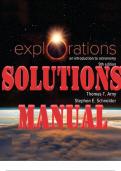
-
SOLUTIONS MANUAL for Explorations: Introduction to Astronomy 9th Edition by Thomas Arny & Stephen Schneider. ISBN 9781260569896.
- Other • 114 pages • 2024
-
- $27.49
- + learn more
TABLE OF CONTENTS: Preview: The Cosmic Landscape Chapter 1: The Cycles o f the Sky Chapter 2: The Rise of Astronomy Essay 1: Backyard Astronomy Chapter 3: Gravity and Motion Chapter 4: Light and Atoms Essay 2: Special and General Relativity Chapter 5: Telescopes Chapter 6: Earth Chapter 7: The Moon and Tides Essay 3: Keeping Time Chapter 8: The Terrestrial Planets Chapter 9: The Giant Planets Chapter 10: Small Bodies Orbiting the Sun Chapter 11: Planetary Systems Essay 4: Life in the Universe Ch...
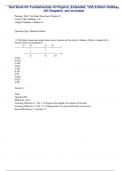
-
Test Bank for Fundamentals of Physics, Extended, 12th Edition by David Halliday
- Exam (elaborations) • 957 pages • 2024
-
- $39.49
- 1x sold
- + learn more
Test Bank for Fundamentals of Physics, Extended, 12e 12th Edition by David Halliday, Robert Resnick, Jearl Walker. Full Chapters test bank are included - Chapter 1 to 44 1 Measurement 1 1.1 Measuring Things, Including Lengths 1 1.2 Time 5 1.3 Mass 6 2 Motion Along a Straight Line 13 2.1 Position, Displacement, and Average Velocity 13 2.2 Instantaneous Velocity and Speed 18 2.3 Acceleration 20 2.4 Constant Acceleration 23 2.5 Free-Fall Acceleration 28 2.6 Graphica...
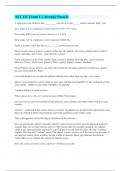
-
AST 111 Exam 1 || Already Passed.
- Exam (elaborations) • 15 pages • 2024
-
Available in package deal
-
- $11.99
- + learn more
A lightyear is the distance that _________ can travel in one _____ correct answers light, year How many km in a lightyear? correct answers 9.50 x 10^12 km How many KM in an AU correct answers 1.5 x 10^8 How many AU in a lightyear correct answers 63,000 AU Earth is a planet while the Sun is a________ correct answers Star Solar System correct answers consists of the sun, the planets, and some smaller bodies such as moon, asteroids, and comets - one planetary system Name the plane...

Did you know that on average a seller on Stuvia earns $82 per month selling study resources? Hmm, hint, hint. Discover all about earning on Stuvia


